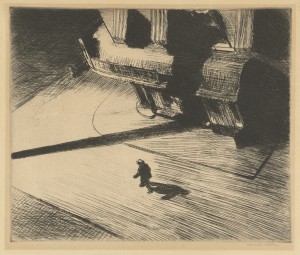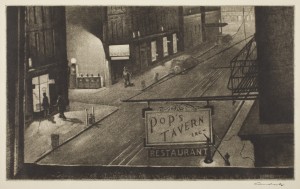This post is one in a series highlighting the special exhibition Nightfall: Prints of the Dark Hours, which explores evocative artistic images of night, called nocturnes. The exhibition is on view through March 22, 2016, in the VMFA Works on Paper Focus Gallery. Admission is free.
During the 19th and 20th centuries, rampant industrialization and urbanization led to a new understanding of nighttime. According to scholar William Chapman Sharpe, who specializes in the culture of the modern American city:
The concept of “nightlife” was born, along with the twenty-four-hour workday. With reliable lighting came safer streets, late shopping, and vastly expanded entertainments. The illumination of the city changed the very way people thought about—and thus lived in—the night. Darkness, so long a barrier to human activity, quickly became a stimulant.

Edward Hopper (American, 1882–1967), Night Shadows, 1921, etching, 10 3/4 x 13 7/8 in. Gift of Malcolm B. Bradley, 2009.356
Although this “nightlife” is often discussed as wielding some mystical quality by which instances of joy, danger, or intimacy are enhanced, instances of solace, loneliness, and meandering in the artificially-lit night remain. In Nightfall, two etchings by American artists Edward Hopper (1882–1967) and Armin Landeck (1905–1984) focus on such less glamorous moments.
In Hopper’s Night Shadows (1921), a single figure walks in the middle of a New York City street at night. The only other discernible presences in this etching are a looming building to the right, a fire hydrant in the distance, and the shadow of the light pole that presumably illuminates the street. Hopper, a Realist painter and printmaker, had a propensity for presenting the city as a place in which loneliness and despair reign. Although it is natural at first to wonder where the figure is going, it is his seeming lack of a destination that lends this scene an unsettling quality. Hopper referred to his human subjects as “characters in search of a play,” and the solitary walker in Night Shadows appears to be searching for somewhere to belong or perhaps to uncover the promises of the new, illuminated nighttime.

Armin Landeck (American, 1905–1984), Pop’s Tavern, 1934, drypoint, aquatint, 9 7/8 x 13 5/8 in. Promised Gift of Frank Raysor, FR.6090
Armin Landeck’s etching Pop’s Tavern (1934) offers a much less romanticized vision of the same sort of despondency within the urban nightscape. This image seems to be about the city surrounding the human subjects-–its buildings, lights, shop windows—much more than it is about them. Here, the urban landscape itself exists as an autonomous, living thing, underscoring the theme of the dwindling importance of the individual in a world active twenty-four hours a day. That Landeck would title this piece Pop’s Tavern and not Man Approaching Window Shoppers, or even New York City Street Scene, gives the sense that the people he portrays are venturing out into the city at night and visiting a world that truly belongs to the objects and structures that man made, not to man himself.
To be out and about in the artificially lit city night means to extend one’s experience in the outside world to a time that, less than two hundred years ago, was largely considered to be the time for rest. And, as illustrated in these two prints, to be alone in this contrived perpetuity of human activity at night can result in lonely searching for a place to belong within a world that is not particularly interested.
Bailey Goldsborough
Curatorial Intern,
VMFA Department of European Art
Source: Sharpe, William Chapman. New York Nocturne: The City After Dark in Art, Literature, and Photography, 1850–1950. Princeton: University Press, 2008.